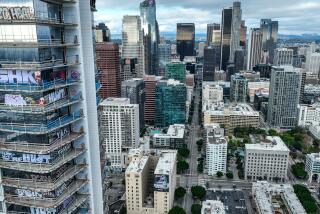It pays to be book smart and street wise
“Read Me! Text in Art” is far more focused than its title suggests. At the Armory Center for the Arts, the 19-artist exhibition, organized by guest curator Malik Gaines, has one foot planted firmly in the classroom and the other in the street. Its best works travel back and forth between these realms, creating pointed conversations between theory and practice, knowledge and experience, the head and the heart.
They do so with an impressive variety of materials, techniques and styles.
A four-part drawing by Andrea Bowers, for instance, looks like a rather uninspired assignment, perhaps a punishment. It is a copy, in pencil and paper, of an online eulogy for Marla Ruzicka and Faiz Ali Salim, an American activist and her Iraqi colleague who were killed last year in a roadside bombing outside Baghdad.
But to draw attention to the American media’s coverage of war, Bowers has copied the text by Phillip Robertson twice. Ruzicka’s two parts of the piece are almost completely filled in with laudatory stories and soulful anecdotes. Salim, in contrast, gets less than two full sentences. His half is almost blank, the paper covered with the metallic blackness of intently applied graphite. The silence speaks volumes.
Alexandra Grant turns even further away from written words to capture the slippery intangibility -- and fleeting magic -- of speech. “Portable” consists of a 5-by-6-foot panel over which she has suspended twisted lengths of thin wire. Some serpentine strands spell words, such as “happiness,” “not” and “vote.” Others form letters that do not appear to be in any order. Still others are abstract curlicues, mutant bits of cursive writing gone wrong.
The shadows cast by the wires on the predominantly white panel often appear to be more substantial than the strands themselves. To complicate matters even more, Grant has traced some of the shadows in pencil, creating odd echoes that resonate in the mind’s eye.
Her low-relief sculpture is the visual equivalent of overheard conversations, when snippets of sense intermingle with incoherence and nothing is clear or certain.
Lisa Anne Auerbach’s three knit sweaters and skirts turn the bodies they cover into billboards, their cheeky messages and snazzy graphics providing a provocative combination of savvy and sass. A three-minute, two-channel video installation by the collective My Barbarian blends revolutionary rhetoric and a lilting pop melody into a potent mixture that is simultaneously lighthearted and melancholy, glib and profound, slick and substantial. Likewise, Glenn Ligon’s modestly scaled text painting is both formally tough and painfully funny, a point-blank fusion of street smarts and intellectual sophistication.
Some of the works that fall short cleave too exclusively to the classroom. Vishal Jugdeo’s video installation, “A Piece for Leaky Ears,” comes off as an undigested homage to such academic theoreticians as Jacques Lacan and Michel Foucault. Similarly, Emily Roysdon’s “POW” gets in over its head by evoking Bruce Nauman’s far simpler -- and more powerful -- videos from the 1960s, ‘70s and ‘80s. And Guan Rong’s mural-size canvas is so petulant, self-involved and grandiose that it recalls the worst days of being a teen without adding any insight about those oversensitive years. It’s an eye-roller that nearly makes you mutter, “Grow up.”
Other pieces, by Dustin Ericksen, Ken Lum and Glynnis Reed, borrow freely from the street. But taking images of advertisements and graffiti, digitally manipulating them and then arranging them in tasteful compositions does little to capture the dynamic vitality of everyday life. Like uninspired essays by second-rate sociologists, these works engage mundane reality in too detached a manner to be captivating.
Mary Kelly’s nearly 20-foot-long piece combines lint from her dryer with a printed story about atrocities in South Africa. The relationship between lint and state-sanctioned murder is never broached.
The radical disjuncture between the medium and the message makes Kelly’s work seem to be an academic exercise -- an arbitrary juxtaposition that is static and sheds little light on its subject.
In contrast, the successful works in “Read Me!” start conversations by bringing form and content into contact with each other. They do not merely overlay disparate realms but transform them into something new and different: art.
--
‘Read Me! Text in Art’
Where: Armory Center for the Arts, 145 N. Raymond Ave., Pasadena
When: Noon to 5 p.m. Tuesdays through Sundays
Ends: Feb. 24
Price: Free
Contact: (626) 792-5101 or www.armoryarts.org
More to Read
The biggest entertainment stories
Get our big stories about Hollywood, film, television, music, arts, culture and more right in your inbox as soon as they publish.
You may occasionally receive promotional content from the Los Angeles Times.










